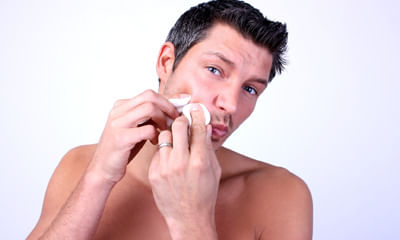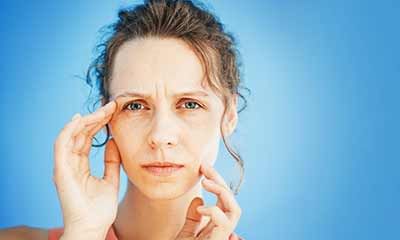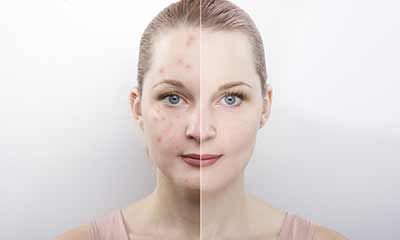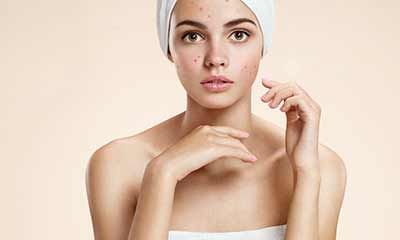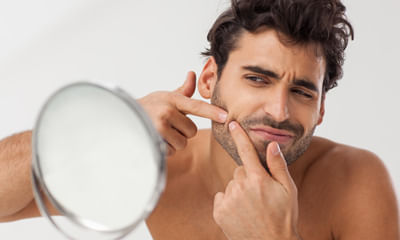Large Painful Pimple Under Skin
I already used v wash for cleaning private parts. Bt a large no of pimples type arises in my vagina after sex. Its very ...
Ask Free Question
1.You should maintain high grade of personal hygiene. 2.Do change your underclothes at least 2 times a day 3.Wear cotton under garments 4.Stay hydrated. Drink plenty of fluids. 5.Keep the area dry for more details you can consult me.
I am 16 male. I have a lot of acne and whiteheads on my face. I tired many medicines and products but nothing worked. I ...
Ask Free Question
Hello, as you are worried and have tried many commercial products which do more harm than good, try these home remedies. Dilute one part apple cider vinegar with three to four parts water (use four if you have sensitive skin), and then apply all over your face using a cotton ball or pad like apple cider vinegar, lemon juice contains citric acid. It also boasts l-ascorbic acid, a natural astringent and antioxidant. Lemon is good remedy- dip a clean cotton swab in fresh lemon juice and apply it to the pimples before going to bed. You can also mix one tablespoon of lemon juice with one teaspoon of cinnamon powder and put it on the pimples overnight. In the morning, wash the skin well with lukewarm water.
I am facing large number of acnes on my face it very itching and painful some times it burst out is there any solution f ...
Ask Free Question
It is a kind of skin disease and requires proper treatment. Just using creams and face wash does not cure it. You can consult me at lybrate for homoeopathic treatment..
Hi, I am getting pimples (I think so) on my legs. It starts from a tiny red bump with a black spot in between and slowly ...
Ask Free Question
Take calendula 30. It is Homoeopathic treatment. It is advisable to take proper treatment under physician's assistant. You can consult me through Lybrate
I am 17 years old female and I had many pimples on my face and now the pimples have gone but it have left many large dee ...
Ask Free Question
Acne can be a painful and embarrassing skin condition, and the scars it leaves behind are an unwelcome reminder of that. A dermatologist can help remove raised or pitted scars. While hyper-pigmented blemishes may fade after several months, you can help speed up the process. Realistically, you will not be able to make acne scars disappear in a single night, but the remedies, products, treatments, and skincare tips will certainly produce a noticeable difference over time. Apply fresh lemon juice. Lemon juice has natural skin bleaching properties, and can help to effectively lighten your acne scars. Simply combine equal parts lemon juice and water and apply this liquid directly onto your scars, avoiding the surrounding skin. Wash off the lemon juice after 15 to 25 minutes or you could put the lemon juice on overnight as a mask. Use honey. Honey is a great natural solution for clearing up pimples and reducing the red marks they leave behind. This is because honey contains antibacterial properties and helps to soothe the skin and reduce inflammation. Raw or manuka honey is the most effective. It can be dabbed directly onto the scarred area, using a q-tip. Experiment with aloe vera. The sap of the aloe vera plant is a soothing natural substance which can be used to relieve many ailments, from burns to wounds to acne scars. Aloe vera helps to rejuvenate and moisturize the skin, encouraging acne scars to fade. It is possible to buy aloe vera products in the drugstore, but the best thing to do is buy an aloe vera plant and use the sap from a broken leaf. This gel-like sap can be applied directly on the scarring, and there is no need to wash off. Use an ice cube. Ice is an extremely simple home remedy which can help to fade acne scars by soothing the inflamed skin and reducing redness. To use, just wrap an ice cube in a clean cloth or piece of paper towel and hold it against the scarred skin for a minute or two, til the area starts to feel numb. Sometimes it can burn. For medication consult online in private.
I am suffering from acne vulgaris for last 2 yrs. Sometimes it vanishes completely but sometimes it takes a horrible loo ...
Ask Free Question
Hi Lybrate user for your problem you can do homopathic treatment it's totally cured. Totally stop any market chemical products, use only organic face wash, cream, now you can take Neem juice capsule &Aloe vera juice capsule. If you want you can consult with me privately. Take care.
I have lots of acne and pimple on my face and I get treatment from 3 doctors but it didn't work on my face permanently. ...
Ask Free Question
What Is Acne? Acne is a common skin condition which causes spots and pimples, particularly on the face, neck, back, shoulders, chest, and upper arms. Acne popularly happens in individuals who are going through puberty. Acne can be worse for people having oily skin. Acne signs and symptoms: Acne signs and symptoms vary depending on the severity of your condition Whiteheads (closed plugged pores) Blackheads (open plugged pores) Small red, tender bumps (papules) Pimples (pustules), which are papules with pus at their tips Large, solid, painful lumps beneath the surface of the skin (nodules) Painful, pus-filled lumps beneath the surface of the skin (cystic lesions) Causes: Excess oil production Hair follicles clogged by oil and dead skin cells Bacteria Excess activity of a type of hormone (androgens) Acne typically appears on your face, forehead, chest, upper back and shoulders because these areas of skin have the most oil (sebaceous) glands. Hair follicles are connected to oil glands. The follicle wall may bulge and produce a whitehead. Or the plug may be open to the surface and darken, causing a blackhead. A blackhead may look like dirt stuck in pores. But actually the pore is congested with bacteria and oil, which turns brown when it's exposed to the air. Pimples are raised red spots with a white center that develop when blocked hair follicles become inflamed or infected with bacteria. Blockages and inflammation that develop deep inside hair follicles produce cystlike lumps beneath the surface of your skin. Other pores in your skin, which are the openings of the sweat glands, aren't usually involved in acne. What to eat: Just cutting out the damaging foods listed above will likely lead to clearer skin—especially if you were regularly consuming them before. But what if you’re already eating healthy? Are there certain foods that could give you the edge against acne? Research is in its earliest stages, but we do have some knowledge of particular foods that may help. Here are five of them: FISH OR FLAXSEED The typical Western diet contains too many omega-6 fatty acids, which are tied to inflammation. Eating more omega-3 fatty acids, such as those found in fatty fish, walnuts, flaxseed, and the like, can help tame inflammation and improve acne breakouts. GREEN TEA Green tea is filled the antioxidants that can protect from environmental stressors. Drink more green tea throughout the day. JUICING Eating more fruits and vegetables can naturally help clear up acne, and juicing is a great way to do so. Many contain beta-carotenes, which naturally help reduce skin oils, and all are naturally anti-inflammatory. Dark, leafy greens also help clear impurities from the body, PROBIOTICS These have been found to reduce inflammation in the gut, which may help reduce acne. According to a 2011 study, intestinal microflora may affect inflammation throughout the body, which in turn, can affect acne breakouts. Since pre and probiotics can reduce inflammation and oxidative stress, scientists believe they may help reduce acne breakouts OYSTERS Eat more oysters, toasted wheat germ (sprinkled on salads and steamed veggies), veal liver, roast beef, roasted pumpkin and squash seeds, and dried watermelon seeds Aloe Vera Aloe vera contains antibacterial properties, which help prevent the formation of cystic acne. Besides, it also contains essential minerals, vitamins, amino acids, proteins and enzymes, which are very good for skin. Cut aloe vera and then apply its gel directly to your affected skin. Apply this remedy 3- 4 times a week. Peel 300g of fresh aloe vera and take out aloe vera juice Drink a glass of aloe vera juice daily After washing the face, apply fresh aloe vera gel directly to your affected area Leave it on for 15-20 minutes before rinsing it off with cool water. Eat 10-20g of aloe vera daily by cooking tea or adding to your dishes Baking Soda Mix 1 tsp. Of baking soda with some cucumber juice or plain water to create a thin paste. Then, apply this paste on your affected area. Leave it on for several minutes before rinsing it off with warm water. Finally, use a moisturizer Repeat this remedy once or twice per week. Lavender Oil Apply some lavender oil on your affected area .Firstly, wash your face thoroughly Add 4- 5 drops of lavender oil to a bowl of hot water Then, use a towel to cover your head and lean over the steam for 5- 10 minutes. Repeat this remedy 2- 3 times a week. Neem Apply the paste made from some neem leaves on your affected skin. When it dries on its own, rinse it off with lukewarm water. Repeat this remedy twice daily for several days. Apply some neem oil on your affected area with the help of a cotton ball. Leave it on for 10 minutes before washing it off using warm water. Turmeric turmeric works as a natural antiseptic to help you fight off infection. Add some water or sesame oil to about 1-2 tsp. Of powdered turmeric to create a paste. Then, apply this paste on your affected area Let it sit on for about 60 minutes before washing it off with water. Add ½ tsp. Of powdered turmeric to a glass of lukewarm milk Drink this solution twice daily. Garlic Cut a small garlic slice and use it to cover the acne Leave it on for about 20 minutes before rinsing it off with water. Crush 2-3 fresh garlic cloves Then, add some fresh water and rub it directly to your affected area Leave it on 20 minutes before rinsing it off with water Remove the shells of 6 fresh garlic cloves Then, soak them in 1 tsp. Of raw honey. Store them in the dark about 2-3 months. After that, apply this mixture directly on the cystic acne. Leave it on 20-30 minutes before rinsing it off with cool water. Repeat this remedy 2-3 times per week. However, when using garlic to treat cystic acne, discontinue right away if you notice skin redness and itching. Also, remember to protect the skin before going out. Cucumber This is worth mentioning in the list of home remedies for cystic acne on nose, cheek and forehead that you should consider making use at home. Using cucumber is known as one of the best home remedies for cystic acne thanks to its high content of vitamins A, B1, B2, C, iron, etc. Slice a cucumber and wash your facial skin Apply cucumber slices on your face Leave it on for 20 minutes before washing it off with clean water Repeat this remedy 2-3 times a week what not to eat: Studies so far have focused mostly on the foods that make acne worse. Here are the five that come up most often as culprits in increasing breakouts. Avoid these for about a week, and see if you notice a difference. 1.cow’s milk. 2.sugar. 3.high-glycemic foods. 4.junk food. 5.fast food. Homeopathy has best solution for acne. For complete cure detail history of the patient is essential.
Hello doctors, My friend 24 years old male. He got something kind of big pimple on his tongue. Its inside of the tongue ...
Ask Free Question
Hi, Types of Pimples on the Tongue: Signs and Symptoms Pimples on the tongue come in different shades and sizes: they can be white, yellow, red, or black, and they can appear anywhere. You can even get a pimple on the tip of the tongue. Here is a little more about the types of pimples you may find. 1. Yellow Pimple A yellow pimple on the tongue could be a cold sore, or even oral herpes. This painful yellow pimple will appear on your tongue, lips, or mouth. It’s a sexually transmitted disease that will often cause red blisters, which then turn into a yellow crust when they dry. Canker sores can also look yellow, and are surrounded by a red outline. 2. White Pimple It’s quite possible to have white pimples on any part of the tongue. The main causes of white tongue pimples are leukoplakia, oral lichen planus, canker sores, and oral thrush. You may also get them from dental appliances, tongue piercings, or from biting or burning your tongue. 3. Side Pimple A pimple on the side of your tongue is often the result of oral herpes, oral thrush, fibroma, allergic reactions, canker sores, oral lichen planus, fibroma, and nutritional deficiencies. A pimple on the side of the tongue can appear on either side, and can look red, yellow, white, or black. 4. Red Pimple Cold sores are the most common cause of a red pimple on the tongue. A red blister on the tongue is swollen, and may break open and leak a clear fluid that forms a scab after a few days. Other causes of a red pimple on the tongue include canker sores and Kawasaki syndrome. 5. Black Pimple Are black spots on your tongue something to worry about? This condition has multiple causes such as allergic reactions, black hairy tongue, oral cancer, tongue piercing, oral fibroma, hyperpigmentation, and tongue trauma or injury. 6. Tip of Tongue These pimples can be white, red, big, small, painless, or painful. Tongue-tip pimples share many causes of other tongue pimples, such as cold sores or canker sores. 7. Back of Tongue A pimple on the back of your tongue may be a different story. You may have red, white, big, or small bumps at the back of your tongue. Some of the possible causes include Kawasaki syndrome, leukoplakia, oral thrush, scarlet fever, allergies, or canker sores. What Are the Causes of a Pimple on the Tongue? As mentioned, many types of pimples can appear on your tongue. The following is a detailed description of their potential causes. 1. Allergies A pimple on the tongue can be a symptom of food allergies. Certain foods, mouth or lip-care products, and medications can all cause allergic reactions, and pimples on your tongue may occur as an immune response. 2. Tongue Injuries or Trauma Pimples on the tongue can also form due to accidental tongue injuries or trauma such as tongue biting, eating hard or tough food, dental appliances such as braces, and tongue piercings. Tongue traumas or injuries will bruise or irritate your tongue, and cause a painful bump on the tongue, especially on the tip or the side. As they begin to heal, these tongue pimples will appear white. 3. Oral Thrush Oral thrush is also called oral Candida or a fungal infection. Oral thrush will release red pimples as a reaction from your taste buds being irritated. In the case of oral thrush, red pimples on the tongue can be found on the sides, tip, or back of your tongue. 4. Viral Infections or STDs There are a variety of viral infections that can lead to white pimples on the tongue, lips, and other areas of the mouth. Some of these viral infections include the flu, cold sores, and oral herpes. A pimple on the tongue due to oral herpes tends to ooze a clear pus-like liquid. Other flu-like symptoms may also accompany a pimple on the tongue, including a fever, a sore throat, dry cough, fatigue, and weakness. 5. Canker Sores A canker sore, or mouth ulcer, is a small lesion that often develops at the base of the gums or on tissues in your mouth. Canker sores appear somewhat like pimples, and can make eating and talking difficult. Potential causes of tongue cankers include food allergies, stress, nutritional deficiencies, viral infections, or hormonal changes. 6. Oral Cancer Stubborn frequent and swollen pimples on the tongue could be a sign of oral cancer. Other oral cancer symptoms include unexplained bleeding in the mouth, unexplained numbness of the mouth, dramatic weight loss, ear pain, and difficulty swallowing or chewing. 7. Kawasaki Disease Kawasaki disease, also called mucocutaneous lymph node syndrome, produces large red bumps on the back of the tongue. Aside from these bumps, Kawasaki disease also affects the lymph nodes, mucous membrane's 8. Leukoplakia In leukoplakia, thick white patches or pimples form on your tongue, on the insides your cheeks, or on the bottom of the mouth. Chewing or smoking tobacco is thought to be a key cause of leukoplakia, and some leukoplakia patches are an early sign of cancer. Leukoplakia usually affects people with a weak immune system due to medications or conditions such as HIV/AIDS. 9. Hairy Black Tongue Hairy black tongue is caused by a buildup of bacteria or yeast on the tongue. Black, white, or yellow discolorations are common with hairy black tongue. Other symptoms will include bad breath, a metallic taste in the mouth 10. Oral Lichen Planus Oral lichen planus is an inflammatory condition that affects the mucous membranes of your mouth. Other Causes of Tongue Pimples Other causes include inflamed and swollen lingual papillae, clogged tongue skin, digestive problems, poor oral hygiene, and stress. If you have fear of surgery then consult a homeopathy doctor he can cure this condition.
Pimples are on my chicks and lower chin very tiny and increasing day by day help me with a tablet. ...
Ask Free Question
Acne. There are several reasons for acne Thyroid Diabetes Hormonal imbalances Pcod Fibroids Genetic factors Severe stress Puberty. Homeopathy has best solution for your problem with out any side effects but history of the patient is necessary. Acne signs and symptoms Whiteheads (closed plugged pores) Blackheads (open plugged pores) Small red, tender bumps (papules) Pimples (pustules), which are papules with pus at their tips Large, solid, painful lumps beneath the surface of the skin (nodules) Painful, pus-filled lumps beneath the surface of the skin (cystic lesions) Causes : Excess oil production Hair follicles clogged by oil and dead skin cells Bacteria Excess activity of a type of hormone (androgens) Acne typically appears on your face, forehead, chest, upper back and shoulders because these areas of skin have the most oil (sebaceous) glands. Hair follicles are connected to oil glands. The follicle wall may bulge and produce a whitehead. Or the plug may be open to the surface and darken, causing a blackhead. A blackhead may look like dirt stuck in pores. But actually the pore is congested with bacteria and oil, which turns brown when it's exposed to the air. Pimples are raised red spots with a white center that develop when blocked hair follicles become inflamed or infected with bacteria. Blockages and inflammation that develop deep inside hair follicles produce cystlike lumps beneath the surface of your skin. Other pores in your skin, which are the openings of the sweat glands, aren't usually involved in acne. What to eat: FISH OR FLAXSEED The typical Western diet contains too many omega-6 fatty acids, which are tied to inflammation. Eating more omega-3 fatty acids, such as those found in fatty fish, walnuts, flaxseed, and the like, can help tame inflammation and improve acne breakouts. GREEN TEA Green tea is filled the antioxidants that can protect from environmental stressors. Drink more green tea throughout the day. JUICING Eating more fruits and vegetables can naturally help clear up acne, and juicing is a great way to do so. Many contain beta-carotenes, which naturally help reduce skin oils, and all are naturally anti-inflammatory. Dark, leafy greens also help clear impurities from the body, PROBIOTICS These have been found to reduce inflammation in the gut, which may help reduce acne. According to a 2011 study, intestinal microflora may affect inflammation throughout the body, which in turn, can affect acne breakouts. Since pre and probiotics can reduce inflammation and oxidative stress, scientists believe they may help reduce acne breakouts. Aloe Vera Aloe vera contains antibacterial properties, which help prevent the formation of cystic acne. Besides, it also contains essential minerals, vitamins, amino acids, proteins and enzymes, which are very good for skin. Cut aloe vera and then apply its gel directly to your affected skin. Apply this remedy 3- 4 times a week. Drink a glass of aloe vera juice daily After washing the face, apply fresh aloe vera gel directly to your affected area Leave it on for 15-20 minutes before rinsing it off with cool water. Eat 10-20g of aloe vera daily by cooking tea or adding to your dishes Baking Soda Mix 1 tsp. Of baking soda with some cucumber juice or plain water to create a thin paste. Then, apply this paste on your affected area. Leave it on for several minutes before rinsing it off with warm water. Finally, use a moisturizer Repeat this remedy once or twice per week. Lavender Oil Apply some lavender oil on your affected area .Firstly, wash your face thoroughly Add 4- 5 drops of lavender oil to a bowl of hot water Then, use a towel to cover your head and lean over the steam for 5- 10 minutes. Repeat this remedy 2- 3 times a week. Neem Apply the paste made from some neem leaves on your affected skin. When it dries on its own, rinse it off with lukewarm water. Repeat this remedy twice daily for several days. Apply some neem oil on your affected area with the help of a cotton ball. Leave it on for 10 minutes before washing it off using warm water. Turmeric turmeric works as a natural antiseptic to help you fight off infection. Add some water or sesame oil to about 1-2 tsp. Of powdered turmeric to create a paste. Then, apply this paste on your affected area Let it sit on for about 60 minutes before washing it off with water. Add ½ tsp. Of powdered turmeric to a glass of lukewarm milk Drink this solution twice daily. Garlic Cut a small garlic slice and use it to cover the acne Leave it on for about 20 minutes before rinsing it off with water. Crush 2-3 fresh garlic cloves Then, add some fresh water and rub it directly to your affected area Leave it on 20 minutes before rinsing it off with water Remove the shells of 6 fresh garlic cloves Then, soak them in 1 tsp. Of raw honey. Store them in the dark about 2-3 months. After that, apply this mixture directly on the cystic acne. Leave it on 20-30 minutes before rinsing it off with cool water. However, when using garlic to treat cystic acne, discontinue right away Cucumber This is worth mentioning in the list of home remedies for cystic acne on nose, cheek and forehead that you should consider making use at home. Using cucumber is known as one of the best home remedies for cystic acne thanks to its high content of vitamins A, B1, B2, C, iron, etc. Slice a cucumber and wash your facial skin Leave it on for 20 minutes before washing it off with clean water.
Hi I'm 20 years of age and facing Acne problem plus their spots and pores. How can I treat them. ...
Ask Free Question
Hello, here are some facts about acne treatment that shall help you- Acne What is Acne? Both males and females suffer from acne. Acne means a condition when you have blackheads, white heads (small white bumps on skin giving uneven look ), pimples that may eventually lead to pus filled painful large pimples that leave marks and scars on face. Why does Acne occur? It can occur due to improper diet, hormonal fluctuations, using inappropriate cosmetic products and sticky creams, humidity, sweating and dead skin collection causing blocked pores or due to some medicines. How can I get a permanent solution for acne and get a clean glowing face? Its your over all diet and exercise routine, with proper sleep and water intake, under guidance of a skin doctor that will help you get a permanent solution for acne. There are 3 steps of acne treatments. First to stop and heal the acne, then to take care of the marks and spots, and lastly to get rid of scars to get a smooth skin. A combination treatment is required including oral medicines, vitamins and antioxidants, creams and sunscreen, chemical peels, medical facials, resurfacing and rejuvenating lasers and PRP. 6-8 months are required for complete recovery. Tips to prevent and deal with acne: Do not touch, press or rub the pimples. Do not use hair products, creams and cosmetics without doctor’s advice. Always remove your make up before going to bed. Use non sticky sunscreen that suits your skin. Use mild pH balanced cleansers for your face. Apply ice on painful pimples, it will help in reducing pain and redness. If you have acne, consult a dermatologist and get complete treatment following proper protocol.

